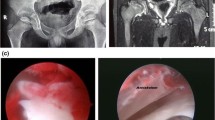Summary
Between 1990 and 1996, 129 children (mean age 4.8 years) with hip pain were examined consecutively. In group I (n = 100, mean age 4.14 ± 2.2), transient synovitis of the hip was diagnosed; group II (n = 29, mean age 7.3 ± 2.1) showed the following diagnoses: Perthes' disease (n = 12), early slipped capital femoral epiphysis (n = 5), Meyer's dysplasia (n = 2), septic arthritis of the hip (n = 2), osteomyelitis of the acetabulum (n = 1), abscess of the psoas (n = 1), chondromatosis of the hip joint (n = 1), Ewing's sarcoma of the os pubis (n = 1), hip dysplasia (n = 1). Three patients who had synovitis developed Perthes' disease and were assigned to group II. The efficiency of ultrasound, scintigraphy and MRI as diagnostic tools was tested in the examination of painful hip. A capsular distension was present in 73 cases and showed a significant statistical difference (t-test, P < 0.001) in group I between affected and unaffected hips. There were no differences in the measurements of the epiphyseal and metaphyseal width in group I between the affected and the non-affected side (t-test, P = 0.91, P = 0.57) and between the first sonographic evaluation at presentation and at the follow-up (t-test, P = 0.053, P = 0.75). MRI was performed, because of persistent joint effusion, in 10 cases in group I, and Perthes' disease was excluded. In group II the use of an MRI allowed the diagnosis in 89 % of the cases. Sonographic examination, together with X-ray examination and serological testing, represent the first choices in the evaluation of a painful hip at presentation and in the follow-up of transient synovitis. MRI should always be performed when abnormalities are present at the clinical and sonographic examination, and when the X-ray does not allow a clear diagnosis.
Zusammenfassung
Zwischen 1990 und 1996 wurden konsekutiv 129 Kinder (Durchschnittsalter 4,8 Jahre) mit dem Leitsymptom Hüftschmerz untersucht. In der Gruppe I (n = 100) wurden die Patienten (Durchschnittsalter 4,14 ± 2,2) mit Coxitis fugax, in der Gruppe II (n = 29) die Patienten (Durchschnittsalter 7,3 ± 2,1) mit folgenden Diagnosen eingereiht: Morbus Perthes (n = 12), subakute Epiphyseolysis capitis femoris (n = 5), Meyer-Dysplasie (n = 2), septische Koxitis (n = 2), Acetabulumosteomyelitis (n = 1), Psoasabszeß (n = 1), Chondromatose des Hüftgelenks (n = 1) Ewing-Sarkom des Os pubis (n = 1), Hüftdysplasie (n = 1); 3 Patienten, die mit einer Synovitis anfangs zur Gruppe I gehörten, entwickelten einen Morbus Perthes und wurden zur Gruppe II gezählt. Die Sonographie, die Szintigraphie und die MRT wurden auf ihren Wert für die Diagnosestellung beim Hüftschmerz überprüft. Bei der sonographischen Untersuchung konnte 73mal eine Kapseldistension, mit einer, in der Gruppe I, statistischen signifikanten Seitendifferenz (t-Test, p < 0.001), nachgewiesen werden. Die Messung der Epiphysen und Metaphysenhöhe in der Gruppe I ergab keine Seitendifferenz sowohl bei der Erstuntersuchung (t-Test, p = 0,91, p = 0,57), wie auch in der Verlaufskontrolle (t-Test, p = 0,053, p = 0,75). Die MRT, die in der Gruppe I, bei persistierendem Erguss, 10mal durchgeführt wurde, konnte einen Morbus Perthes ausschliessen. In der Gruppe II führte sie in 89 % der Fälle zur Diagnose. Die Sonographie ist neben dem Röntgenbild und laborchemischen Untersuchungen die Methode der Wahl zur ersten Abklärung eines Hüftschmerzes und zur Verlaufskontrolle einer Coxitis fugax. Bei einem klinisch und sonographisch atypischen Befund sollte ein MRT veranlaßt werden, sofern das Röntgenbild keine eindeutige Diagnose erlaubt.
Similar content being viewed by others
Author information
Authors and Affiliations
Rights and permissions
About this article
Cite this article
de Pellegrin, M., Fracassetti, D. & Ciampi, P. Transient synovitis of the hip. Role of US, scintigraphy and MRI. Orthopäde 26, 858–867 (1997). https://doi.org/10.1007/PL00003335
Published:
Issue Date:
DOI: https://doi.org/10.1007/PL00003335




